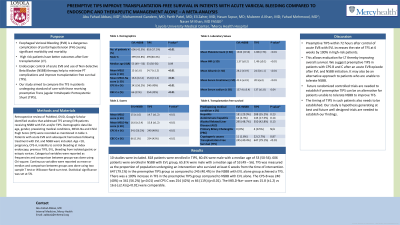Tuesday Poster Session
Category: GI Bleeding
P3494 - Preemptive TIPS Enhance Transplantation-Free Survival in Patients with Acute Variceal Bleeding Compared to Endoscopic and Therapeutic Management Alone: A Meta-Analysis
Tuesday, October 24, 2023
10:30 AM - 4:00 PM PT
Location: Exhibit Hall

Has Audio

Abu Abbasi, MD
Loyola University Medical Center
Maywood, IL
Presenting Author(s)
Abu Fahad Abbasi, MD1, Mohammed Gandam, MD2, Parth Patel, MD2, Hasan Sqour, MD2, Mohammed Khan, MD2, Naser Khan, MD3
1Loyola University Medical Center, Maywood, IL; 2Amita Health Chicago, Chicago, IL; 3MercyHealth, Rockford, IL
Introduction: Esophageal Variceal Bleeding (EVB) is a dangerous complication of portal hypertension (PH) causing significant morbidity and mortality. High-risk patients have better outcomes after liver transplantation (LT). However, endoscopic control of acute EVB and the use of Non-Selective Beta Blocker(NSBB) therapy help to minimize PT complications and improve transplantation-free survival (TFS). Our study aimed to compare the TFS in patients undergoing standard of care with those receiving preemptive Trans jugular Intrahepatic Portosystemic Shunt (TIPS).
Case Description/Methods: Retrospective review of studies on TFS in EVB patients receiving NSBB with EVL and/or TIPS. Demographic data (age, gender, medical conditions, MELD-Na, CPS) were recorded (Table 1). Included patients: acute EVB with hemostasis after EVL and NSBB treatment. Exclusions: age < 18, pregnancy, CPS-A, uncontrolled bleeding, previous TIPS, EVL, bleeding from gastric/ectopic varices. Categorical variables: frequencies and Chi-square test. Continuous variables: mean/median and two-sample T test/Wilcoxon-Rank-sum test. Statistical significance: p< 0.05.
10 studies were included. 818 patients were enrolled in TIPS, 60.4% were male with a median age of 53 (50-56). 606 patients were enrolled in NSBB with EVL group, 65.8 % were male with a median age of 53 (49 – 56). TFS was measured as the proportion of population undergoing an intervention who survived at least 6 weeks from the time of intervention. 647 (79.1%) in the preemptive TIPS group as compared to 245 (40.4%) in the NSBB with EVL alone group achieved a TFS. There was a 100% increase in TFS in the preemptive TIPS group compared to NSBB with EVL alone. The CPS-B was 240 (40%) vs 341 (56.2%) (p< 0.01) and CPS C was 254 (42%) vs 66 (11%) (p< 0.01). The MELD-Na+ score was 15.8 (±1.2) vs 16.6 (±2.4) (p< 0.01) were
comparable.
Discussion: Preemptive TIPS within 72 hours after EVL-controlled acute EVB significantly increases TFS rate by 100% in high-risk patients, improving overall survival. We suggest preemptive TIPS for CPS-B and C patients after EVL and NSBB for acute EVB, potentially as an alternative to NSBB for intolerant patients. Further randomized controlled trials are needed to determine if preemptive TIPS can improve TFS in NSBB-intolerant patients and establish optimal timing. Our study generates hypotheses, emphasizing the need for well-designed future trials.
Disclosures:
Abu Fahad Abbasi, MD1, Mohammed Gandam, MD2, Parth Patel, MD2, Hasan Sqour, MD2, Mohammed Khan, MD2, Naser Khan, MD3. P3494 - Preemptive TIPS Enhance Transplantation-Free Survival in Patients with Acute Variceal Bleeding Compared to Endoscopic and Therapeutic Management Alone: A Meta-Analysis, ACG 2023 Annual Scientific Meeting Abstracts. Vancouver, BC, Canada: American College of Gastroenterology.
1Loyola University Medical Center, Maywood, IL; 2Amita Health Chicago, Chicago, IL; 3MercyHealth, Rockford, IL
Introduction: Esophageal Variceal Bleeding (EVB) is a dangerous complication of portal hypertension (PH) causing significant morbidity and mortality. High-risk patients have better outcomes after liver transplantation (LT). However, endoscopic control of acute EVB and the use of Non-Selective Beta Blocker(NSBB) therapy help to minimize PT complications and improve transplantation-free survival (TFS). Our study aimed to compare the TFS in patients undergoing standard of care with those receiving preemptive Trans jugular Intrahepatic Portosystemic Shunt (TIPS).
Case Description/Methods: Retrospective review of studies on TFS in EVB patients receiving NSBB with EVL and/or TIPS. Demographic data (age, gender, medical conditions, MELD-Na, CPS) were recorded (Table 1). Included patients: acute EVB with hemostasis after EVL and NSBB treatment. Exclusions: age < 18, pregnancy, CPS-A, uncontrolled bleeding, previous TIPS, EVL, bleeding from gastric/ectopic varices. Categorical variables: frequencies and Chi-square test. Continuous variables: mean/median and two-sample T test/Wilcoxon-Rank-sum test. Statistical significance: p< 0.05.
10 studies were included. 818 patients were enrolled in TIPS, 60.4% were male with a median age of 53 (50-56). 606 patients were enrolled in NSBB with EVL group, 65.8 % were male with a median age of 53 (49 – 56). TFS was measured as the proportion of population undergoing an intervention who survived at least 6 weeks from the time of intervention. 647 (79.1%) in the preemptive TIPS group as compared to 245 (40.4%) in the NSBB with EVL alone group achieved a TFS. There was a 100% increase in TFS in the preemptive TIPS group compared to NSBB with EVL alone. The CPS-B was 240 (40%) vs 341 (56.2%) (p< 0.01) and CPS C was 254 (42%) vs 66 (11%) (p< 0.01). The MELD-Na+ score was 15.8 (±1.2) vs 16.6 (±2.4) (p< 0.01) were
comparable.
Discussion: Preemptive TIPS within 72 hours after EVL-controlled acute EVB significantly increases TFS rate by 100% in high-risk patients, improving overall survival. We suggest preemptive TIPS for CPS-B and C patients after EVL and NSBB for acute EVB, potentially as an alternative to NSBB for intolerant patients. Further randomized controlled trials are needed to determine if preemptive TIPS can improve TFS in NSBB-intolerant patients and establish optimal timing. Our study generates hypotheses, emphasizing the need for well-designed future trials.
Disclosures:
Abu Fahad Abbasi indicated no relevant financial relationships.
Mohammed Gandam indicated no relevant financial relationships.
Parth Patel indicated no relevant financial relationships.
Hasan Sqour indicated no relevant financial relationships.
Mohammed Khan indicated no relevant financial relationships.
Naser Khan indicated no relevant financial relationships.
Abu Fahad Abbasi, MD1, Mohammed Gandam, MD2, Parth Patel, MD2, Hasan Sqour, MD2, Mohammed Khan, MD2, Naser Khan, MD3. P3494 - Preemptive TIPS Enhance Transplantation-Free Survival in Patients with Acute Variceal Bleeding Compared to Endoscopic and Therapeutic Management Alone: A Meta-Analysis, ACG 2023 Annual Scientific Meeting Abstracts. Vancouver, BC, Canada: American College of Gastroenterology.
